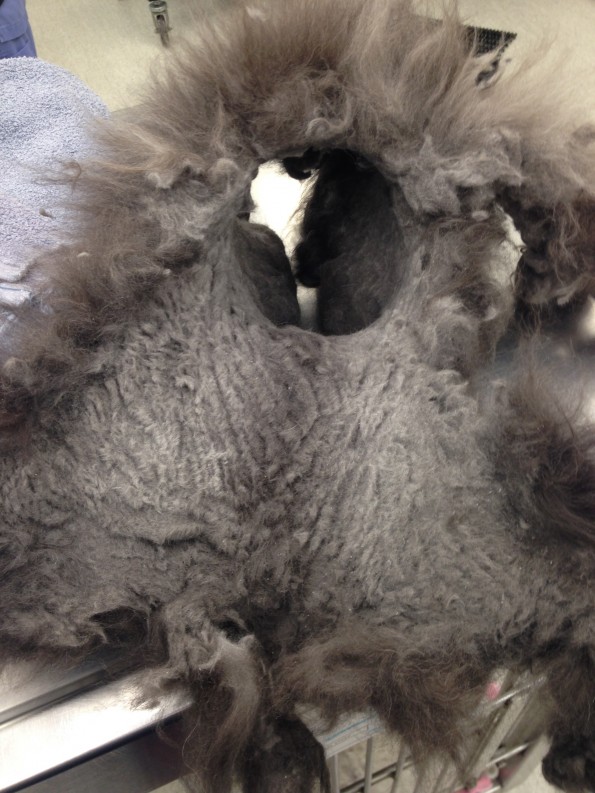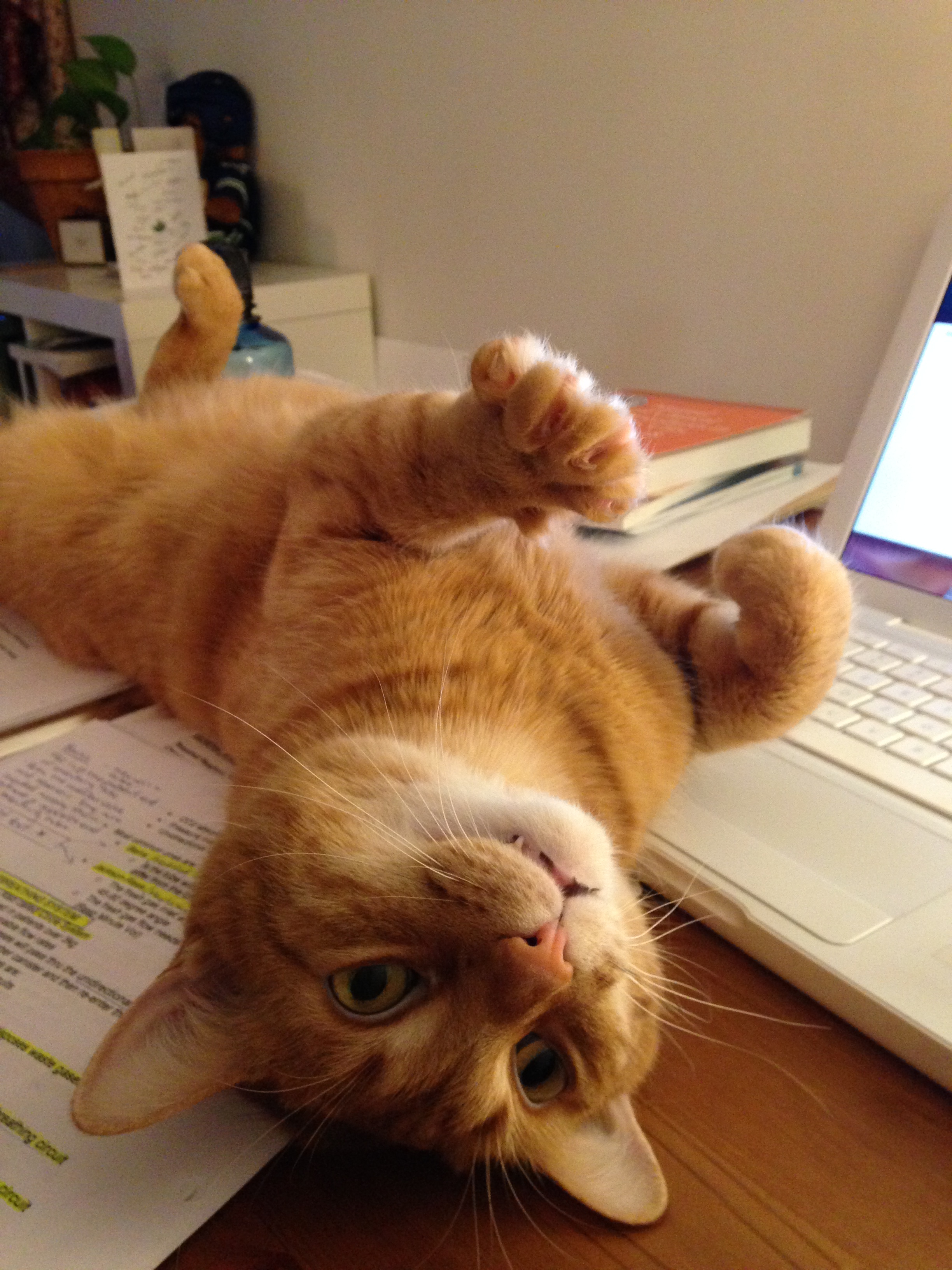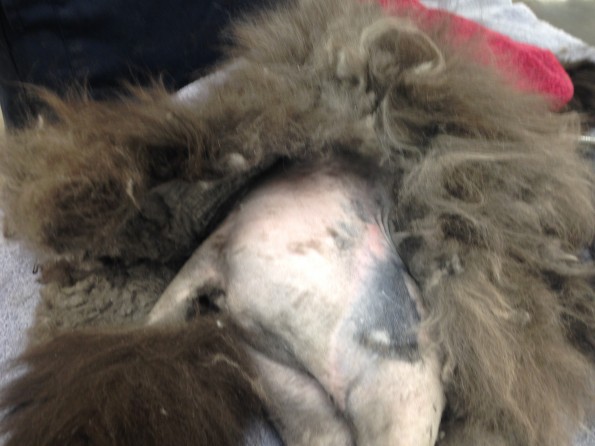Meet ZaZoo! This 7 year old, domestic short-haired orange tabby came into my life as a rescue almost 6 years ago. And albeit devilishly-handsome (if I do say so myself), ZaZoo does not just wake up looking this good. Rather, he spends many hours a day grooming and brushing. The hairbrush is indeed his kryptonite, and he refuses to start any morning without it. I need coffee in the morning, ZaZoo needs his hairbrush; I kid you not! He was 2 years old when I adopted him; I had no idea if he’d ever seen a hairbrush before in his life. He wasn’t matted at all or extremely dirty but because I find myself frequently recommending to clients that they try to groom their own cats more often at home, I thought I’d take my own advice and try brushing ZaZoo.
On the first attempt he gave me “the look.” You know the one I’m talking about. The one that warns, “I don’t know what that was lady but don’t you dare come near me with that again.” The next time I caught him while he was fast asleep. He woke up quickly, flashed me “the look” again, but allowed me to brush him a fraction longer than the first attempt. Each day, I’d incorporate the hairbrush into his morning feeding regimen; a couple brushes, followed by a treat, a couple more brushes accompanied with the usual high-pitched voice praising him for being such a good cat, and a couple more treats. Soon enough, I had created a brush-loving cat that would prefer to be brushed instead of fed in the morning! For those of you who also have the joy of sharing your home with a feline friend, you have no doubt been witness to their own relentless grooming. Cats are naturally fastidious creatures and it’s not uncommon to find them “having a bath” on our beds or on our couches multiple times throughout the day (is it just me, or do they always choose our favorite seat in the house for this?!). And while it seems cats can manage their everyday grooming needs purr-fectly fine on their own, it’s never a bad idea to offer them a hand. Introducing your cat to a hairbrush as early as possible in their life can be beneficial in a variety of ways:
Brushing Helps Prevent Mats Have you ever found any knots when you’ve gone to brush out your own hair? Keeping in mind how painful those little knots are for you and I to get out. Now, try for a moment to imagine yourself covered head to toe in them. Imagine feeling them pulling at your skin all the time and with every step you take or every motion of your arms. Not very comfortable, is it? For some of the felines who frequent our hospital, grooming can be a challenge for them to accomplish all on their own. Factors such as obesity, arthritis, age, health status, the amount and length of their fur, and their lifestyle (ie. indoor or outdoor) can all play a role in their ability to groom themselves thoroughly and properly. For the most part, the occasional mat can be removed quickly and easily but in extreme cases, we have seen kitties completely matted head to toe. Often times these cats come to see us when their owners come in to request a “Lion Shave.” Cats in these cases require heavy sedation and professional shaving in order to safely remove all of their matted fur (leaving some hair on the mane and some on the tail and lower legs). In one such case, the matted fur was nearly an inch thick in some areas. It started behind the cat’s ear and extended (as one piece!) all the way to the base of their tail and down all of their legs. We could only shave a couple millimeters at a time, being careful to avoid cutting the fragile skin and slowly working around the circumference of the cat until eventually we could slide the cat out of the mat. Thankfully these cases are extremely rare.
Taking a short amount of time each day (or as often as you can) to brush your cat’s fur is a simple solution that can help prevent the build-up of painful mats. If you have a long-haired cat, then I cannot stress this point enough. I know that all cats won’t take to the brush as well as ZaZoo did, but start small and work up from there. Try just a little bit at a time, always keep it a positive and happy experience, incorporate treats, follow each brush stroke with a stroke of your hand so that they equate brushing to petting, sneak in a brush or two while they’re sleeping, and be sure to give them lots of praise.

This cats fur was so badly matted it was shaved off in one piece! This could have been easily prevented by regular brushing.
Brushing Reduces Shedding and Lessens Hairballs
One of the many “pleasures” of owning a cat is having cat hair all over your furniture and on every piece of clothing you own. Brushing your cat won’t stop them from shedding on your favorite pair of black pants, but it can help reduce the amount of hair floating around your home. And of course, we can’t ignore the hairballs on our carpets. Cats naturally have little barbs on their tongues to assist them with grooming. It is normal for loose hair, debris, and small foreign objects to get picked up by their tongue, swallowed, and passed through their body exiting in their stool. However, occasionally they (especially long-haired cats) have a difficult time digesting large amounts of hair, so it gathers in their stomachs until they eventually need to vomit it back up. Brushing your cat will help reduce the amount of loose hair and debris they swallow and thus the amount or frequency of hairballs staining your rug.
Brushing Smoothes and Waterproofs Their Coat
Brushing and grooming a cat helps to smooth their fur. This smoothing action insulates the body more efficiently and the bristles from the brush (or the barbs on the tongue) encourage the glands at the base of each hair to release and spread their natural oils, called sebum, across the fur. This oil helps to protect and waterproof their hair and skin.
Brushing Helps You Bond with Your Cat
Although we assume cats to be rather independent creatures, a large majority of them actually enjoy bountiful amounts of attention and cuddles. This is also a great time to introduce them to a brush! Some may take to it quickly, others may need time, but we find most do enjoy getting brushed and it allows you the time to relax, play, and bond with your cat.
I know ZaZoo’s particular obsession with the hairbrush is unique (to say the least), but I encourage you to give it a try with your kitties at home; it will be beneficial to the both of you!



